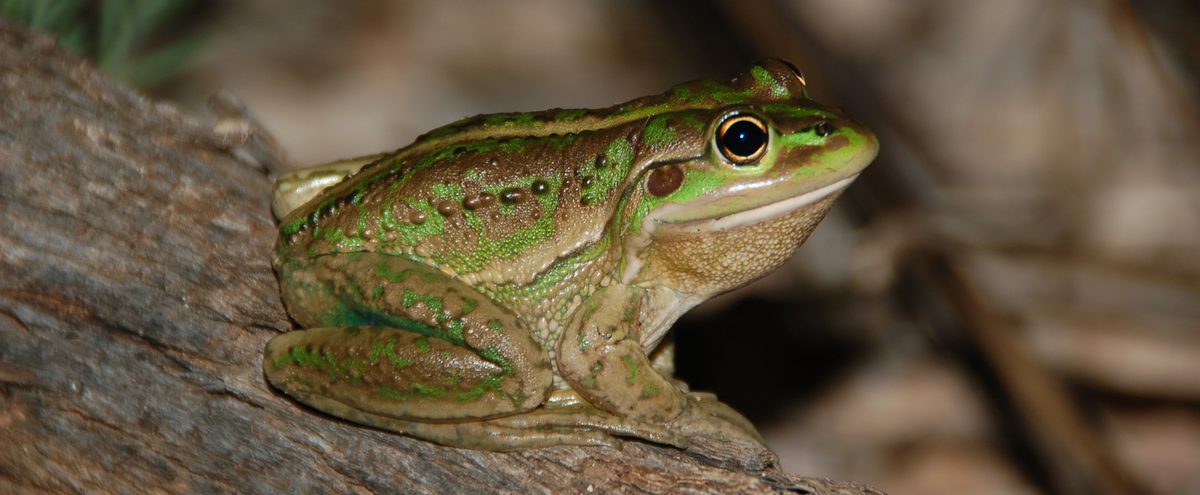
Southern bell frog

The southern bell frog (Ranoidea raniformis) is considered the region’s largest frog species and occupies both permanent and temporary wetlands. Its distribution and abundance have greatly diminished over recent years leading to its current conservation status as a vulnerable species.
Southern bell frogs are large compared to other frogs, growing up to 10 cm. They have warty, bright green skin with golden-coloured patches and large black or brown spots on the back. Typically, they have a pale green stripe along the middle of their back and bright turquoise blue on their thighs. They have finger and toe pads, only slightly wider than their fingers and toes. Their fingers are not webbed, but the toes are almost fully webbed.

The southern bell frog feeds at night, eating small water bugs, beetles, termites, insect and larvae. They even eat other frogs! They are opportunistic predators and will sit and wait to ambush whatever prey comes within reach.
In spring and summer, the male calls to attract a mate while floating in open water or under aquatic vegetation. Females lay jelly-like masses of eggs (up to 4,000) typically after rainfall or flooding. Two days later, the tadpoles hatch and hide in vegetation near the waters’ edge where the water is shallower and warmer. The tadpoles can grow up to 100 mm long, are pinkish-grey with yellow fins and transform into frogs in summer or autumn. Out of all the frogs in the region, they take the longest to metamorphosise - up to three months!

Where do southern bell frogs live?
In South Australia they are found throughout the River Murray and South East in large permanent waterbodies with abundant growth of vegetation near the bank.
They are most active during spring and summer, often seen basking in the sun. In winter they’re likely to be found in groups beneath thick beds of reeds along the edges of wetlands.

Why are southern bell frogs threatened?
There are many factors influencing the southern bell frog’s survival, including:
- Removal of aquatic vegetation and trampling by grazing animals, which reduces wetland habitat.
- Weirs that have created a series of still ‘lakes’ along the river.
- Increased water use resulting in far fewer floods, limiting opportunities to breed.
- Introduced Eastern Gambusia which may prey on their eggs and tadpoles.
- Chemical pollution and salinisation.
- Introduction of European carp – their bottom dwelling habits impact aquatic vegetation.
What is being done to help southern bell frogs?
Research is required to further understand the factors influencing the southern bell frog’s decline. Programs such as the FrogWatch SA seasonal census and FrogSpotter are helping to improve knowledge of the distribution and abundance of frogs in South Australia. A regional recovery program is helping by implementing recovery actions for the species in the River Murray corridor.
Murraylands and Riverland Landscape Board ecologists undertook a southern bell frog recruitment project from 2019-2021 in temporary wetlands in the Riverland, SA. The study looked at delivering a targeted regime to maintain water levels within temporary wetlands to provide resources to southern bell frogs through their critical metamorphosis process. This targeted approach and other recent studies demonstrated that the delivery of e-water via targeted pumping can support the successful recruitment of many frog species, particularly the southern bell frog.
Help save the southern bell frog
- If you see a southern bell frog, please do not disturb it – observe it from a distance.
- Report sightings to the Murraylands and Riverland Landscape Board Ecologist – phone 8580 1800.
- Consider our frogs and other native aquatic species – please avoid polluting our waterways, removing vegetation or logs from wetlands and collecting tadpoles from wetlands.
- Help with the FrogWatch SA seasonal census or use the FrogSpotter app in your local wetlands.
